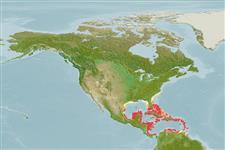Environment: milieu / climate zone / depth range / distribution range
Ecología
marino asociado a arrecife. Subtropical; - 9°N
Western Atlantic: Florida, Bahamas, N. & W. Caribbean, & Antilles south to St. Kitts.
Tamaño / Peso / Age
Maturity: Lm ? range ? - ? cm
Max length : 4.0 cm TL macho / no sexado; (Ref. 7251)
Short description
Morfología | Morfometría
Espinas dorsales (total): 15; Radios blandos dorsales (total): 8-9; Espinas anales 2; Radios blandos anales: 16 - 17. This species is distinguished by the following characters: naked belly, pectoral-fin base, and cheek; adults with spiny preorbital bone; blunt snout; 3 rows of scales above rear pored scales, first 2 rows about equal-sized; first dorsal fin relatively short; fifth body bar prominently darker than first 4 and typically wider than 4-5 interspace; first four body bars are usually indistinct, often barely distinguishable; 4-5 interspace without central dark patch or dark accessory bar; 2 broad and solid dark or dusky red bands on caudal fin (in breeding males all dark); pale band flanked with dark or red stripes from eye across upper jaw; second dorsal fin with 3 rounded dark spots on membranes near the spine bases and thin band of fine speckling on outer rim of fin; anal fin with 4 or 5 dark patches; mode of D III+XII+8 and A II, 16; mode of 15 pored lateral-line scales and 21 scales in notched midline row (Ref. 93957).
Adults inhabit patch reefs and rocky bottoms (Ref. 5521). Eggs are hemispherical and covered with numerous sticky threads that anchor them in the algae on the nesting sites (Ref. 240). Larvae are planktonic which occur primarily in shallow, nearshore waters (Ref. 94114).
Life cycle and mating behavior
Madurez | Reproducción | Puesta | Huevos | Fecundidad | Larva
Victor, B.C., 2013. The Caribbean roughhead triplefin (Enneanectes boehlkei): DNA barcoding reveals a complex of four West Indian sympatric cryptic species (Teleostei: Blennioidei: Tripterygiidae). J. Ocean Sci. Found. 7:44-73. (Ref. 93957)
IUCN Red List Status (Ref. 130435)
Threat to humans
Harmless
Human uses
Acuario: Comercial
Más información
Age/SizeCrecimientoLength-weightLength-lengthLength-frequenciesMorfometríaMorfologíaLarvaDinámica larvariaReclutamientoAbundanciaBRUVS
ReferenciasAcuiculturaPerfil de acuiculturaRazasGenéticaElectrophoresesheritabilidadEnfermedadesProcesamientoNutrientsMass conversion
ColaboradoresImágenesStamps, Coins Misc.SonidosCiguateraVelocidadTipo de nataciónSuperficie branquialOtolitosCerebrosVisión
Herramientas
Special reports
Download XML
Fuentes de Internet
Estimates based on models
Preferred temperature (Ref.
123201): 26.3 - 28.2, mean 27.4 °C (based on 531 cells).
Phylogenetic diversity index (Ref.
82804): PD
50 = 0.5001 [Uniqueness, from 0.5 = low to 2.0 = high].
Bayesian length-weight: a=0.00562 (0.00258 - 0.01228), b=3.08 (2.89 - 3.27), in cm total length, based on LWR estimates for this (Sub)family-body shape (Ref.
93245).
Nivel trófico (Ref.
69278): 2.7 ±0.3 se; based on size and trophs of closest relatives
Resiliencia (Ref.
120179): Alto, población duplicada en un tiempo mínimo inferior a 15 meses (Preliminary K or Fecundity.).
Fishing Vulnerability (Ref.
59153): Low vulnerability (10 of 100).
Nutrients (Ref.
124155): Calcium = 308 [99, 1,348] mg/100g; Iron = 2.52 [0.83, 6.27] mg/100g; Protein = 18.9 [16.9, 20.8] %; Omega3 = 0.146 [0.030, 0.713] g/100g; Selenium = 31.8 [5.2, 162.5] μg/100g; VitaminA = 22.1 [2.1, 231.9] μg/100g; Zinc = 3.96 [1.54, 8.13] mg/100g (wet weight);
